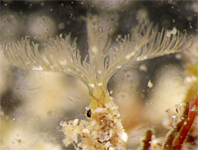Abstract
Epibiosis is common among ciliates and crustaceans because the calcified surface of the crustacean body offers a suitable site for colonization by the epibiont. Suctoria are among the most common epibiont ciliate groups of freshwater decapod crustaceans. The aim of this study is to increase knowledge of suctorians as epibionts of freshwater decapod crustaceans of the families Cambaridae and Pseudothelphusidae. Crustaceans were collected from three rivers and one pond in Chiapas, Mexico. Six species of suctorian epibionts were recorded: Acineta tuberosa, Podophrya maupasi, P. sandi, Tokophrya cyclopum, T. quadripartita and Trichophrya epistylidis. This is the first record of ciliate epibionts on members of family Pseudothelphusidae (represented by Phrygiopilus montebelloensis and Raddaus bocourti), and the first record of suctorians epibionts on Procambarus (Austrocambarus) sp. (Cambaridae).
References
Álvarez, F., Villalobos, J.L., Armendáriz, G. & Hernández, C. (2012) Relación biogeográfica entre cangrejos dulceacuícolas y acociles a lo largo de la zona mexicana de transición: reevaluación de la hipótesis de Rodríguez (1986). Revista Mexicana de Biodiversidad, 83, 1073–1083.
Álvarez, F., Villalobos, J.L., Hendrickx, M., Escobar-Briones, E., Rodríguez-Almaraz, G. & Campos, E. (2014) Biodiversity of decapod crustaceans (Crustacea: Decapoda) in Mexico. Revista Mexicana de Biodiversidad, 85, 208–219.
https://doi.org/10.7550/rmb.38758
Batisse, A. (1994) Sous-classe des Chonotrichia Wallengren, 1895. In: Grassé, P.P. (Ed.), Traité de Zoologie. Masson, Paris, pp. 433–473.
Curds, C.R. (1985a) A revision of the Suctoria (Ciliophora, Kinetofragminophora). 1. Acineta and its morphological relatives. Bulletin of the British Museum of Natural History, Zoology, 48, 75–129.
https://doi.org/10.5962/bhl.part.6511
Curds, C.R. (1985b) A revision of the Suctoria (Ciliophora, Kinetofragminophora). 3. Tokophrya and its morphological relatives. Bulletin of the British Museum of Natural History. Zoology, 49 (2), 167–193.
https://doi.org/10.5962/bhl.part.6511
Curds, C.R. (1986) A revision of the Suctoria (Ciliophora, Kinetofragminophora). 4 Podophrya and its morphological ralatives. Bulletin of the British Museum of Natural History, Zoology, 50 (2), 59–91.
Dovgal, I.V. (2002) Evolution, phylogeny and classification of Suctorea Claparède et Lachmann, 1858. Protistology, 2 (4), 194–270.
Dovgal, I. (2013) Fauna of Ukraine: 40 (36) Ciliates—Ciliophora. Issue 1: Class Suctorea. Naukova dumka, Kiev, 267 pp.
Fernandez-Leborans, G. (2006) Inter-annual variability of the epibiotic community on Pagurus bernhardus from Scotland. Estuarine, Coastal and Shelf Science, 66 (12), 35–54.
https://doi.org/10.1016/j.ecss.2005.07.016
Fernandez-Leborans, G. (2010) Epibiosis in Crustacea: an overview. Crustaceana, 83 (5), 549–640.
https://doi.org/10.1163/001121610X491059
Fernandez-Leborans, G. & Tato-Porto, M. (2000) A review of the species of protozoan epibionts on crustaceans. II. Suctorian Ciliates. Crustaceana, 73 (10), 1205–1327.
https://doi.org/10.1163/156854000505209
Fernandez-Leborans, G. & Gabilondo, R. (2006) Taxonomy and distribution of the hydrozoan and protozoan epibionts on Pagurus bernhardus (Linnaeus, 1758) (Crustacea, Decapoda) from Scotland. Acta Zoologica, 87 (1), 33–48.
https://doi.org/10.1111/j.1463-6395.2006.00218.x
Hobbs, H. (1991) Decapoda. In: Thorp, J. & Covich, A. (Eds.), Ecology and classification of North American freshwater invertebrates. Academic Press, New York, pp. 823–858.
López-Ochoterena, E. & Ochoa-Gasca, E. (1971) Protozoarios ciliados de México. XVII. Algunos aspectos biológicos de veinte especies epizoicas del crustáceo Cambarellus montezumae zempoalensis Villalobos. Revista Latinoamericana de Microbiología, 13 (3), 221–231.
Lynn, D.H. (2017) Ciliophora. In: Archibald, J.M., Simpson, A.G.B. & Slamovits, C.H. (Eds.), Handbook of the protists. Springer, Cham, Switzerland, pp. 679–730.
https://doi.org/10.1007/978-3-319-28149-0_23
Matthes, D. & Guhl, W. (1973) Sessile ciliaten der flusskrebse. Protistologica, 9, 459–470.
Matthes, D., Guhl, W. & Haider, G. (1988) Suctoria und Urceolariidae. Protozoenfauna. Band 7/1. Gustav Fisher Verlag, Stuttgart, 309 pp.
Mayén-Estrada, R. & Aladro-Lubel, M.A. (1998) Tres especies de suctores (Protozoa: Ciliophora) ectosimbiontes del acocil Cambarellus (Cambarellus) patzcuarensis. Anales del Instituto de Biología, Universidad Nacional Autónoma de México, Serie Zoología, 69 (1), 1–12.
Morado, J. & Small, E. (1995) Ciliate parasites and related diseases of Crustacea, a review. Reviews in Fisheries Science, 3, 275–354.
https://doi.org/10.1080/10641269509388575
Threlkeld, S.T., Chiavelli, D.A. & Willey, R.L. (1993) The organization of zooplankton epibiont communities. Trends in Ecology and Evolution, 8 (9), 317–321.
https://doi.org/10.1016/0169-5347(93)90238-K
Utz, L. & Coats, W. (2005) Spatial and temporal patterns in the occurrence of peritrich ciliates as epibionts on calanoid copepods in the Chesapeake Bay, USA. Journal of Eukaryotic Microbiology, 52, 236–244.
https://doi.org/10.1111/j.1550-7408.2005.00025.x
Villalobos, J.L., Álvarez, F., Hernández, C., Lanza-Espino, G. & González-Mora, D. (2010) Decapod crustaceans from Copalita, Zimatán and Coyula basins, in Oaxaca, Mexico. Revista Mexicana de Biodiversidad, 81, 99–111.
Wahl, M. (2008) Ecological lever and interface ecology: epibiosis modulates the interactions between host and environment. Biofouling, 24 (6), 27–38.

